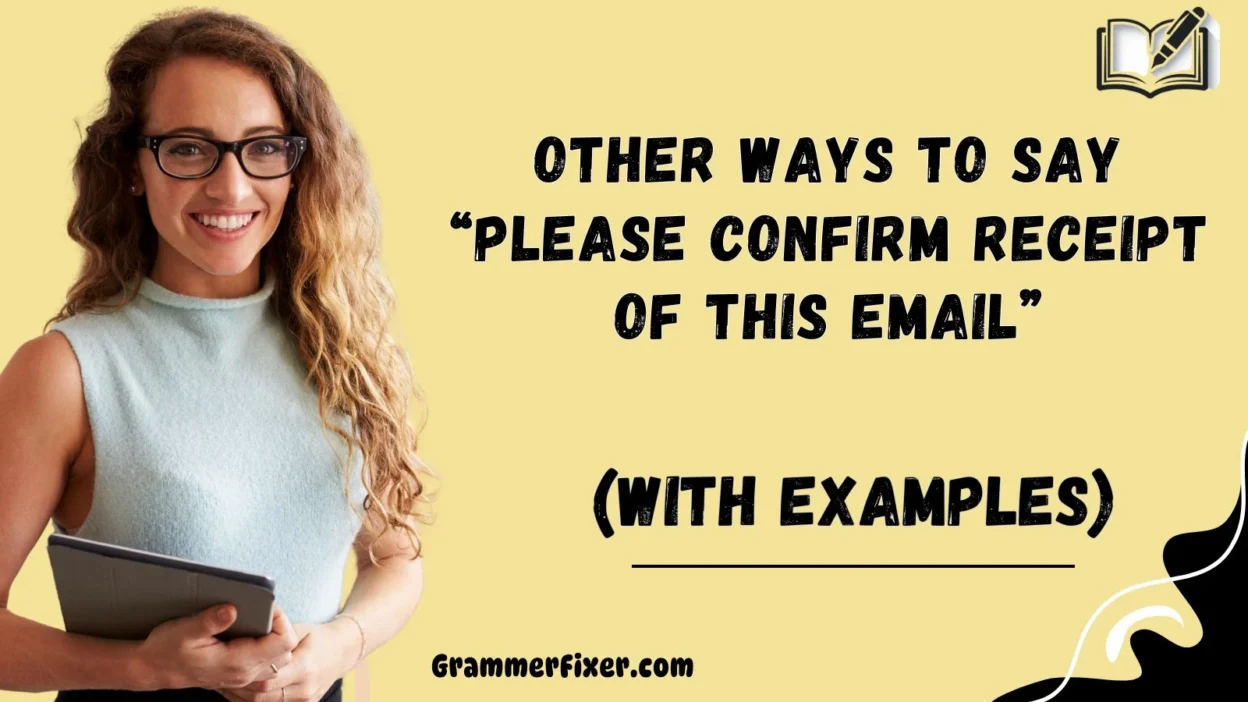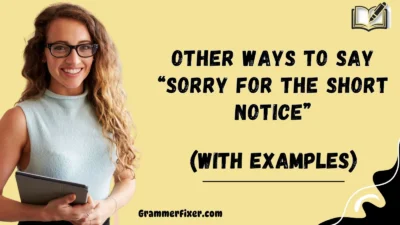Finding the right words when communicating over email is a subtle art. A phrase like “Please confirm receipt of this email” is clear and professional, but it can sometimes feel stiff, repetitive, or impersonal.
By using alternatives, you can show care, warmth, and professionalism, while also tailoring your request to fit the context and your relationship with the recipient.
This guide provides 30 thoughtful alternatives—with examples and detailed notes—so you can ensure your emails are both acknowledged and appreciated.
What Does “Please Confirm Receipt of This Email” Mean?
It is a request for confirmation. The sender wants the recipient to verify that the message, along with any attachments, has arrived safely and is being reviewed. This helps avoid misunderstandings, provides a record of communication, and ensures that any required actions are on track.
When to Use “Please Confirm Receipt of This Email”?
Use this phrase (or its alternatives) when:
- You’re sharing important documents (contracts, invoices, reports).
- The context requires accountability (legal, compliance, audits).
- You want to avoid missed deadlines or overlooked tasks.
- You’re sending job applications, proposals, or project updates.
Is It Professional/Polite to Say “Please Confirm Receipt of This Email”?
Yes—it’s professional and polite, especially in formal contexts. But if you’re writing to colleagues or long-term contacts, overusing it may feel pushy or unnecessary. A lighter phrase may be better in day-to-day communication.
Pros or Cons of Saying “Please Confirm Receipt of This Email”
Pros:
- Ensures the recipient acknowledges your email.
- Reduces misunderstandings.
- Provides a record of communication.
- Signals professionalism and attention to detail.
Cons:
- May feel robotic or stiff if used too often.
- Can sound demanding in informal exchanges.
- Might be ignored in busy inboxes.
- Could contribute to email overload.
1. Kindly Acknowledge Receipt
Meaning: A courteous request for confirmation.
Detailed Explanation: The word “kindly” softens the request, making it feel respectful and thoughtful.
Scenario Example:
“I’ve attached the updated project draft. Kindly acknowledge receipt so I know it has reached you.”
Best Use: Ideal for formal emails to clients, partners, or managers.
Worst Use: Avoid in casual internal emails where it may sound overly formal or stiff.
Tone: Polite, professional, respectful
2. Please Let Me Know When You Receive This
Meaning: A friendly, straightforward request.
Detailed Explanation: This phrasing feels personal and less rigid than “confirm receipt.” It focuses on timing.
Scenario Example:
“I’m sending over the revised proposal. Please let me know when you receive this.”
Best Use: Great for colleagues, teammates, or project collaborators.
Worst Use: Not suitable for formal legal or compliance emails where precision is required.
Tone: Warm, approachable, conversational
3. Could You Confirm You’ve Received My Message?
Meaning: A polite way of requesting acknowledgment as a question.
Detailed Explanation: By framing it as “Could you”, it reduces the sense of a demand and shows consideration.
Scenario Example:
“Just checking—could you confirm you’ve received my message about tomorrow’s meeting?”
Best Use: Useful in follow-ups with clients, managers, or team leads.
Worst Use: Avoid in urgent situations where you need a quick confirmation—this phrasing may sound too soft.
Tone: Considerate, professional, diplomatic
4. Please Confirm Upon Receipt
Meaning: A direct yet polite request for acknowledgment.
Detailed Explanation: This phrase highlights timeliness, asking the recipient to confirm right when they receive the email.
Scenario Example:
“I’m forwarding the signed contract. Please confirm upon receipt so we can proceed to the next steps.”
Best Use: Effective in formal business communications where documentation and acknowledgment are essential.
Worst Use: Avoid in friendly or casual exchanges, where it may sound too stiff or official.
Tone: Formal, professional, precise
5. Kindly Confirm Once You Have Reviewed
Meaning: A respectful request for acknowledgment after review.
Detailed Explanation: This version acknowledges that the recipient may need to read or check the content before replying.
Scenario Example:
“Attached is the Q3 report. Kindly confirm once you have reviewed the details.”
Best Use: Useful when sending detailed documents (reports, proposals, contracts).
Worst Use: Avoid in quick exchanges where you only need acknowledgment of receipt, not review.
Tone: Considerate, formal, professional
6. Please Acknowledge This Email
Meaning: A straightforward way to ask for acknowledgment.
Detailed Explanation: This is direct but still professional. It keeps the request short and clear.
Scenario Example:
“I’ve shared the latest performance metrics. Please acknowledge this email for our records.”
Best Use: Appropriate for official documentation, HR communications, or policy updates.
Worst Use: Can feel too cold or robotic in casual team communication.
Tone: Direct, formal, clear
7. Looking Forward to Your Confirmation
Meaning: A polite, expectation-setting request.
Detailed Explanation: This phrase shows optimism and signals that you expect acknowledgment.
Scenario Example:
“Thank you for reviewing the draft. Looking forward to your confirmation so we can finalize.”
Best Use: Best for collaborative work settings where positive tone matters.
Worst Use: Avoid in urgent or compliance-driven emails—it may sound too casual.
Tone: Friendly, positive, semi-formal
8. A Quick Reply Would Be Appreciated
Meaning: A polite way to request a timely acknowledgment.
Detailed Explanation: This version places emphasis on timeliness without sounding forceful.
Scenario Example:
“I’ve attached the revised proposal. A quick reply would be appreciated so we can keep the project on track.”
Best Use: Great for internal team updates or time-sensitive communications.
Worst Use: Avoid with senior executives or in formal contracts, where the wording might sound too casual.
Tone: Polite, time-conscious, professional
9. Please Respond to Confirm
Meaning: A short and simple acknowledgment request.
Detailed Explanation: This phrasing is direct, leaving little room for ambiguity.
Scenario Example:
“I’ve attached the signed agreement. Please respond to confirm its receipt.”
Best Use: Ideal for official communications where clear acknowledgment is necessary.
Worst Use: Not suitable for informal or friendly emails, where it may feel too commanding.
Tone: Direct, clear, formal
10. Kindly Let Me Know Once You’ve Received This
Meaning: A softer alternative that blends politeness and clarity.
Detailed Explanation: It’s conversational but still maintains professionalism by using “kindly.”
Scenario Example:
“Here is the updated invoice. Kindly let me know once you’ve received this.”
Best Use: Excellent for client communication where maintaining professional warmth is important.
Worst Use: Avoid in brief internal messages, where it may seem overly wordy.
Tone: Polite, approachable, semi-formal
11. Please Confirm Safe Delivery
Meaning: A polite way to check that an email or attachment has arrived securely.
Detailed Explanation: This emphasizes security and successful delivery, especially for sensitive files.
Scenario Example:
“I’ve sent over the signed contract. Please confirm safe delivery when you can.”
Best Use: Great for legal, financial, or compliance-related documents.
Worst Use: Overly formal for everyday team updates or casual communication.
Tone: Formal, cautious, professional
12. Just Checking If This Landed in Your Inbox
Meaning: A casual, friendly way of confirming receipt.
Detailed Explanation: This phrase makes the request sound light and conversational, almost like a gentle nudge.
Scenario Example:
“Hi Alex, just checking if this landed in your inbox—sent over the mockups earlier today.”
Best Use: Perfect for colleagues, team members, or informal collaborations.
Worst Use: Avoid with external partners, executives, or clients, as it may seem too casual.
Tone: Informal, relaxed, friendly
13. Kindly Reply to Confirm
Meaning: A straightforward but polite request for acknowledgment.
Detailed Explanation: Adding “kindly” balances the directness of “reply to confirm” with courtesy.
Scenario Example:
“Attached is the finalized project proposal. Kindly reply to confirm its receipt.”
Best Use: Suitable for semi-formal client or stakeholder emails.
Worst Use: Not ideal for quick back-and-forth internal conversations, where brevity is better.
Tone: Polite, professional, semi-formal
14. Please Let Me Know Once You’ve Had a Chance to Review
Meaning: A considerate request that allows time for review.
Detailed Explanation: This not only asks for acknowledgment but also gives the recipient space to check the document.
Scenario Example:
“I’ve shared the updated report. Please let me know once you’ve had a chance to review.”
Best Use: Great for managers, clients, or colleagues reviewing detailed documents.
Worst Use: Avoid in urgent situations, where you need quick confirmation rather than after-review acknowledgment.
Tone: Respectful, patient, professional
15. Appreciate Your Confirmation
Meaning: A short, gratitude-centered request.
Detailed Explanation: This wording emphasizes thankfulness while keeping the request simple.
Scenario Example:
“I’ve attached the updated performance metrics. Appreciate your confirmation.”
Best Use: Effective for professional peers or clients where positive tone matters.
Worst Use: Can feel abrupt in highly formal emails, since it drops supporting words.
Tone: Grateful, polite, professional
16. Please Get Back to Me Once You’ve Received This
Meaning: A polite but slightly urgent way to request acknowledgment.
Detailed Explanation: This phrase blends courtesy with a call for a timely response.
Scenario Example:
“I’ve shared the draft proposal. Please get back to me once you’ve received this.”
Best Use: Appropriate for team communications or project collaborations.
Worst Use: Avoid in strict legal or compliance messages, where “get back to me” may sound too casual.
Tone: Semi-formal, approachable, polite
17. Kindly Confirm by Return Email
Meaning: A formal request for acknowledgment via reply.
Detailed Explanation: This traditional phrasing is still widely used in official correspondence.
Scenario Example:
“I am sending you the updated contract. Kindly confirm by return email.”
Best Use: Ideal for formal, professional, and legal settings.
Worst Use: Too formal for everyday workplace communication with colleagues.
Tone: Formal, respectful, professional
18. Please Reply Once Received
Meaning: A clear, no-frills request.
Detailed Explanation: Keeps the message short while still being professional and polite.
Scenario Example:
“Here are the final design assets. Please reply once received.”
Best Use: Good for colleagues, managers, or project partners in a straightforward setting.
Worst Use: May feel blunt in client-facing emails where warmth is expected.
Tone: Direct, concise, professional
19. Kindly Confirm Receipt at Your Earliest Convenience
Meaning: A respectful and flexible request.
Detailed Explanation: Balances formality with consideration for the recipient’s schedule.
Scenario Example:
“Attached is the quarterly report. Kindly confirm receipt at your earliest convenience.”
Best Use: Excellent for clients, executives, or higher-ups.
Worst Use: Too formal for daily team check-ins or casual workplace updates.
Tone: Polite, formal, considerate
20. Please Advise Once You’ve Received This
Meaning: A courteous way to request acknowledgment and guidance if needed.
Detailed Explanation: This phrase implies both confirmation and the possibility of next steps.
Scenario Example:
“I’ve sent the updated policy draft. Please advise once you’ve received this.”
Best Use: Useful for management, compliance, or policy-related communication.
Worst Use: Avoid in casual settings, where “advise” may sound overly serious.
Tone: Formal, professional, respectful
21. Acknowledge Receipt When Possible
Meaning: A polite way to request confirmation without adding pressure.
Detailed Explanation: This phrase signals flexibility, allowing the recipient to respond at their convenience.
Scenario Example:
“I’ve attached the expense report. Please acknowledge receipt when possible.”
Best Use: Suitable for semi-formal communication with colleagues or partners.
Worst Use: Not ideal for urgent or time-sensitive matters, since it doesn’t emphasize quick action.
Tone: Flexible, polite, semi-formal
22. Please Let Me Know Once It Reaches You
Meaning: A conversational way to confirm delivery.
Detailed Explanation: The phrase makes it feel more like a friendly update request than a demand.
Scenario Example:
“I just forwarded the updated designs. Please let me know once it reaches you.”
Best Use: Great for friendly workplace communication with colleagues.
Worst Use: Avoid in formal or contractual communication, where precision is key.
Tone: Casual, friendly, conversational
23. A Short Note Back Would Be Great
Meaning: A light, informal way to ask for acknowledgment.
Detailed Explanation: This phrasing emphasizes ease and friendliness, making the request feel less formal.
Scenario Example:
“Sent over the meeting agenda. A short note back would be great.”
Best Use: Works well in casual or day-to-day team communication.
Worst Use: Not suitable for executives, clients, or formal contexts.
Tone: Informal, light, approachable
24. Please Confirm You’ve Got This
Meaning: A simple, conversational request.
Detailed Explanation: “Got this” keeps it casual but still communicates the need for acknowledgment.
Scenario Example:
“Here’s the draft timeline. Please confirm you’ve got this.”
Best Use: Suitable for colleagues or informal work settings.
Worst Use: Too casual for client-facing or compliance-related communication.
Tone: Relaxed, casual, straightforward
25. Kindly Confirm Once It Has Arrived
Meaning: A respectful acknowledgment request.
Detailed Explanation: This phrasing frames receipt as an event, emphasizing that the document needs confirmation once received.
Scenario Example:
“The signed agreement has been sent. Kindly confirm once it has arrived.”
Best Use: Ideal for formal or external partner communication.
Worst Use: Overly formal for internal chatty exchanges.
Tone: Formal, respectful, professional
26. Appreciate a Quick Confirmation
Meaning: A concise request that stresses gratitude and timeliness.
Detailed Explanation: This keeps things professional and courteous, while also highlighting speed.
Scenario Example:
“Attached is the monthly performance report. Appreciate a quick confirmation.”
Best Use: Great for time-sensitive communications with colleagues or managers.
Worst Use: Too abrupt for clients or external partners, where a softer phrasing is better.
Tone: Polite, time-conscious, professional
27. Please Confirm Receipt for Record-Keeping
Meaning: A formal request tied to documentation needs.
Detailed Explanation: This version explicitly states that the acknowledgment is for official records.
Scenario Example:
“We’ve shared the finalized HR policy. Please confirm receipt for record-keeping.”
Best Use: Excellent for HR, legal, or compliance-driven communications.
Worst Use: Too formal for day-to-day team messages.
Tone: Formal, clear, administrative
28. Kindly Confirm When Convenient
Meaning: A softer alternative that respects the recipient’s schedule.
Detailed Explanation: This gives the recipient flexibility while still asking for acknowledgment.
Scenario Example:
“I’ve attached the updated marketing strategy. Kindly confirm when convenient.”
Best Use: Good for external partners or busy executives.
Worst Use: Avoid in urgent scenarios where a timely response is critical.
Tone: Polite, considerate, professional
29. Please Confirm So I Know It Reached You
Meaning: A considerate way to ensure delivery is successful.
Detailed Explanation: This phrasing shows care and concern that the recipient actually received the message.
Scenario Example:
“I’m sending the design files now. Please confirm so I know it reached you.”
Best Use: Suitable for collaborative work environments or where technical issues (spam filters, attachments) may occur.
Worst Use: May sound repetitive if used too often in routine communication.
Tone: Friendly, considerate, reassuring
30. Acknowledgment of Receipt Would Be Appreciated
Meaning: A formal, gratitude-driven phrasing.
Detailed Explanation: This makes the request clear while framing it as a courtesy.
Scenario Example:
“Attached is the quarterly budget forecast. Acknowledgment of receipt would be appreciated.”
Best Use: Excellent for official reports, proposals, and communications with clients or executives.
Worst Use: Too heavy for casual internal updates.
Tone: Formal, professional, courteous
Conclusion
Choosing the right way to say “Please confirm receipt of this email” can make your communication more professional, polite, and human-centered. While the phrase itself is clear and effective, relying on a variety of alternatives helps you avoid sounding repetitive, robotic, or pushy, especially in ongoing communication. The best choice depends on the context, urgency, and relationship you share with the recipient—what works well in a formal client report might feel too stiff in a casual team update. By adapting your tone and phrasing, you not only ensure your message is acknowledged but also show consideration, respect, and professionalism, strengthening both your work relationships and the clarity of your communication.



